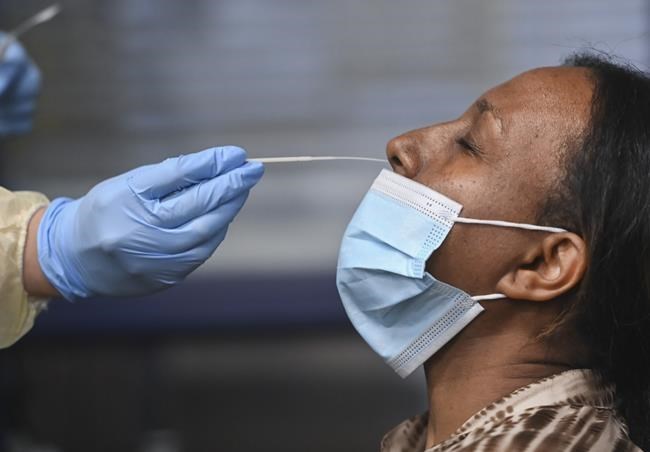TORONTO — The burden of COVID-19 going forward will sit on the shoulders of primary care doctors and nurses if no new variant emerges, but the way that medical care is delivered must be reconsidered, Ontario's now-defunct science table said Monday in its final bit of advice to the province.
The Ontario COVID-19 Science Advisory Table released three briefs that focused on the response to the pandemic by family doctors and nurses.
It found patients who weren't connected with a family doctor or medical team had worse health outcomes during the pandemic. It also found primary care teams better responded to the needs of patients than solo practitioners.
Other findings included unequal distribution of primary care access throughout the province, a dearth of data on that same care and major overall communication problems.
"We're seeing huge numbers of people who are unable to access primary care in Ontario, we've got a workforce that is exhausted and we need to think differently about the care that we're going to be providing in the future," said senior author Dr. Danielle Martin, a family physician and chair of the department of family and community medicine at the University of Toronto.
Public Health Ontario dissolved the independent voluntary science table in early September, with a new group under its watch set to first convene sometime in October.
The briefs are the last bit of research the group performed in its role as pandemic-era government advisors.
Now, table members hope to share the lessons learned over that time.
It says a team-based approach to primary care would better serve patients -- and help address the alarming number of Ontario residents without a family doctor.
That number currently stands at 1.8 million, while 1.7 million Ontarians have a doctor aged 65 or older. And recent research shows the first six months of the pandemic spurred an exodus of family physicians.
"One of the biggest lessons that we found is that people who had a formal relationship with a primary care provider or team have had a better experience of care all through this pandemic," Martin said.
"And that teams were better able to respond than people working as solo practitioners."
She said the province needs to link as many Ontarians as possible, as soon as possible, to primary care.
The table found treating patients with long COVID is taking up increasing time and resources of family doctors.
And with so many procedures and surgeries cancelled because of COVID-19, family doctors and nurses are bearing the brunt of reconnecting patients to the care they need, Martin said. The table suggests primary care teams be expanded to also include pharmacists, physician assistants, social workers and community health workers.
"Otherwise it's going to be very hard for us to recover out of this pandemic in a way that doesn't completely cause collapse of our emergency departments and hospitals," Martin said.
Access to care is not equitable, the science table found, with those in rural communities and the inner suburbs, new Canadians and the marginalized left with low levels of primary care.
"If you're designing the system right, everybody would have it. But if not everyone can have it, it should be the people who need it the most," Martin said.
But there are some community-led initiatives that should be replicated and scaled up, the science table said, citing the Black Creek Community Health Centre in northwest Toronto as an example.
The primary care teams there engaged community ambassadors and organized vaccine clinics during evenings and weekends to accommodate essential workers. That led to significant vaccine uptake from 5.5 per cent of the population in the area in April 2021 to 56.3 per cent a month later.
"Community leaders took the lead and the health-care system for once followed what community leaders had to say and listened and took instruction from people who understood how best to reach their communities," Martin said.
"That needs to be permanent if we want to continue to close those equity gaps and provide better care to Indigenous, Black and other racialized groups."
The science table also found that there is a lack of data on primary care.
"We have hundreds and thousands of independent practices who are using electronic medical records, but we have no way of getting access to that data safely to conduct quality improvement or research," Martin said.
The lack of integrated data "compromised the response in pandemic care," the table wrote.
"This disjointed and non-comprehensive data system means that health system leaders cannot measure what PCCs or teams are doing, who they are serving, and the effectiveness of that care, making it difficult to identify gaps in care," the table said.
There is also no way to communicate easily with family doctors in the province, the table said.
"Even now, after two and a half years in a pandemic, there is no easily accessed centralized list that government or public health officials can use to send a clear single message out to the primary care sector," Martin said. "Imagine that. it is mind-boggling."
The briefs represent the science table's largest single body of work, said Dr. Fahad Razak, the group's scientific director.
"We wanted to focus on primary care as it's been significantly impacted by the pandemic, and increasingly the burden of COVID management will fall on primary care physicians unless a new variant emerges, Razak said.
"This includes not only caring for new infections but also for conditions like long-COVID."
This report by The Canadian Press was first published Oct. 3, 2022.
Liam Casey, The Canadian Press

